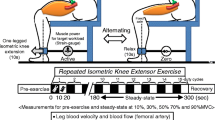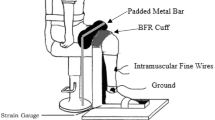Summary
In five healthy males sustained isometric torques during elbow flexion, knee extension, and plantar flexion correlated positively with intramuscular tissue pressure (MTP) in the range 0–80% of the maximal voluntary contraction (MVC). During passive compression of the muscle at rest 133-Xenon muscle clearance stopped when MTP reached diastolic arterial pressure (DAP) indicating that the muscle vascular bed was occluded. However, during sustained contractions this relation between DAP, flow and MTP was not seen. In two cases 133-Xenon clearance from M. soleus did not stop in spite of an 80% maximal contraction and MTP stayed below DAP. In other cases MTP would reach as high as 240 mm Hg before clearance was zero. In the deeper parts of the muscles MTP during contraction was increased in relation to the more superficial parts. The mean values for the %MVC that would stop MBF varied between 50 and 64% MVC for the investigated muscles. Mean rectified EMG (MEMG) showed a high correlation to MTP during sustained exhaustive contractions: When MEMG was kept constant MTP also remained constant while the exerted force decreased; when force was kept constant both MEMG and MTP increased in parallel. This demonstrated that muscle tissue compliance is decreasing during fatigue. Muscle ischemia occuring during sustained isometric contractions is partly due to the developed MTP, where especially the MTP around the veins in the deeper parts of the muscle can be considered of importance. However, ischemia is also affected by muscle fiber texture and anatomical distorsion of tissues.
Similar content being viewed by others
References
Bonde-Petersen F (1960) Muscle training by static, concentric, and eccentric contractions. Acta Physiol Scand 48: 406–416
Bonde-Petersen F, Henriksson J, Lundin B (1975a) Blood flow in thigh muscle during bicycling exercise at varying work rates. Eur J Appl Physiol 34: 191–197
Bonde-Petersen F, MØrk AL, Nielsen E (1975b) Local muscle blood flow and sustained contractions of human arm and back muscles. Eur J Appl Physiol 34: 43–50
Cerretelli P, Pendergast DR, Krasney J, Plewes J, Rennie DW (1979) Central and peripheral blood flow adjustments to exercise in dogs. Physiologist 22: 18
Dahn I, Lassen NA, Westling H (1967) Blood flow in human muscles during external pressur or venous stasis. Clin Sci 32: 467–473
Darcus HD (1951) The maximum torques developed in pronation and supination of the right hand. J Anat (Lond) 85: 55–57
Edwards RHT, Hill DK, McDonnell M (1972) Myothermal and intramuscular pressure measurements during isometric contractions of the human quadriceps muscle. J Physiol (Lond) 224: 58P-59P
Gray SD, Carlsson E, Staub NC (1967) Site of increased vascular resistance during isometric muscle contraction. Am J Physiol 213: 683–689
Hargens AR, Sejersted OM, Kardel KR, Blom P, Hermansen L (1982) Intramuscular fluid pressure: A fonction of contraction force and tissue depth. 28th Annual ORS, New Orleans, Louisiana
Hermiston T, Bonde-Petersen F (1975) The influence of varying oxygen tensions in inspired gas on 133 Xenon muscle clearance and fatigue levels during sustained and dynamic contractions. Eur J Appl Physiol 34: 294–302
Hill AV (1948) The pressure developed in muscle during contraction. J Physiol (Lond) 107: 518–526
Holzman GB, Wagner HN Jr, Ito M, Rabinowitz D, Zierler L (1964) Measurement of muscle blood flow in the human forearm with radioactive krypton and xenon. Circulation 30: 27–34
Kety SS (1949) Measurement of regional circulation by the local clearance of radioactive sodium. Am Heart J 38: 322–328
Lassen NA, Lindbjerg IF, Munck O (1964) Measurements of blood flow through skeletal muscle by intramuscular injections of 133-Xenon. Lancet I: 686–689
Lindbjerg IF (1965) Measurement of muscle blood-flow with 133-Xe after histamine injection as a diagnostic method in peripheral arterial disease. Scand J Clin Lab Invest 17: 371–380
Mazzella H (1953) On the pressure developed by contraction of striated muscle and its influence on muscular circulation. Arch Int Physiol 62: 334–347
Mazzella H, Mendez-Bauer C (1954) The pressure developed by skeletal muscle during contraction. Arch Int Physiol 61: 453–461
MØller E, Rasmussen OC, Bonde-Petersen F (1979) Mechanism of ischemic pain in human muscles of mastication: Intramuscular pressure, EMG, force and blood flow of the temporal and masseter muscles during biting. Advances in Pain Research Therapy 3: 271–281
Nilsson B, Ingvar DH (1967) Intramuscular pressure and contractile strength related to muscle blood flow in man. Scand J Clin Lab Invest Suppl 93: 31–38
Rowell LB (1974) Human cardiovascular adjustments to exercise and thermal stress. Physiol Rev 54: 75–159
Saltin B, SjØgaard G, Gaffney FA, Rowell LB (1981) Potassium, lactate, and water fluxes in human quadriceps muscle during static contractions. Circulation Res [Suppl 1] 48: 18–24
Sylvest O, Hvid N (1959) Pressure measurement in human striated muscles during contraction. Acta Rheumatol Scand 5: 216–222
Wisnes A, KirkebØ A (1976) Regional distribution of blood flow in calf muscles of rat during passive stretch and sustained contraction. Acta Physiol Scand 96: 256–266
Author information
Authors and Affiliations
Additional information
This investigation was supported by the Danish Space Board and the Danish Medical Research Council. Y. Suzuki received a grant from the Danish Space Board
Rights and permissions
About this article
Cite this article
Sadamoto, T., Bonde-Petersen, F. & Suzuki, Y. Skeletal muscle tension, flow, pressure, and EMG during sustained isometric contractions in humans. Europ. J. Appl. Physiol. 51, 395–408 (1983). https://doi.org/10.1007/BF00429076
Accepted:
Issue Date:
DOI: https://doi.org/10.1007/BF00429076




